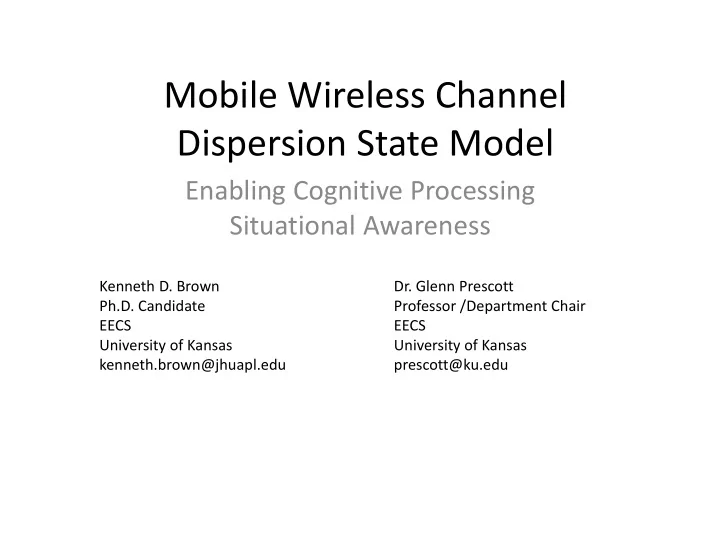

Mobile Wireless Channel Dispersion State Model Enabling Cognitive Processing Situational Awareness Kenneth D. Brown Dr. Glenn Prescott Ph.D. Candidate Professor /Department Chair EECS EECS University of Kansas University of Kansas kenneth.brown@jhuapl.edu prescott@ku.edu
System Modeling Background System engineering models • Behavioral (mathematical, logical, flow, state, others) – Structural (physical, architecture, interface, others ) – Hidden Markov models • Dual statistical model, hidden random sequences, observable random sequences – Initial, transition, output probabilities – Training, generative, evaluation, decoding modes – Applications: automatic speech, image, facial, writing, gait, biological, and network – traffic recognition. Published multistate mobile wireless channel models • • Binary nonfading/fading FSMM, • Variable length Markov chain • Amplitude quantized FSMM, • Average dwell time FSMC • Error rate FSMM • High order FSMM • N-state SNR FSMM • Statistical distribution FSMM • N-state pdf FSMM • State variable models
Mobile Wireless Channel Architectural Model Mobile wireless channel architecture • – TX, mobile channel, RX Cognitive radio CSR architecture • – Software defined processing – Cognitive processing – Environmental sensing – Mobile wireless channel Mobile Wireless Channel System Model
Mobile Wireless Channel Architectural Model Cognitive Radio CSR Architecture
MWC Dispersion State Model Mobile Wireless Channel DSM MWC dispersion state space – • Non dispersive, single time, single frequency, dual time/frequency dispersion • Non fading, flat frequency, frequency selective, time selective DSM state transitions – • Symbol period • Symbol rate No Time Dispersion and No Frequency NTD&NFD Dispersion MTD & MFD Minimal Time Dispersion and Minimal Frequency Dispersion LTD & MFD Large Time Dispersion and Minimal Frequency Dispersion MTD & LFD Minimal Time Dispersion and Large Frequency Dispersion LTD & LFD Large Time Dispersion and Large Frequency Dispersion
MWC Dispersion State Model
CSR Test System CSR Test System Reference waveform generator – Simulink data, TX, channel, RX models – Statistical quantizer – Amplitude histogram bin index – CSR training RWG – DSM FSMM embedded in CSR HMM – Operational sequence decoding – CSR Test System Reference Waveform Generator Output Waveform Quantizer Output
DSM Validation Accuracy Validation Approach CSR Test System – Generate calibrated reference waveforms, – Apply training hidden state sequences to – estimate HMM parameters, Train 5 HMMs with varying combinations – of hidden state sequences, Apply a single calibrated operational – reference waveform Statistical quantization – Decode operational waveform hidden – state sequences Post processing – Enumerate decoded states – Quantify statistical sensitivity CSR Test System – Quantify statistical specificity –
Channel State Recognition HMM Training • Viterbi parameter estimation • Baum ‐ Welch parameter estimation – Initial state probability – State transition probability – Output probabilities
Channel State Recognition HMM Training
CSR Operational Sequence Decoding Hidden Sequence Decoding – Maximum likelihood – Viterbi algorithm – Response to operational sequences • 12345 • 23451 • 34521 • 45123 • 51234
DSM CSR Accuracy Results Statistical Accuracy Decoded hidden state sequences • Statistical accuracy results • Sensitivity – Specificity –
CSR Accuracy Conclusions • None of the HMMs discriminated dual dispersive state 5 from the frequency selective state 3. More effective training required. Output probabilities are similar. • All HMMs recognized the absence of dual dispersive state 5. • All HMMs recognize the presence of nonfading state 1 with >85% accuracy and the absence of state 1 with > 80% accuracy. • Two of the HMMs would recognize the presence of frequency selective state 3 with > 80% accuracy while all HMMs would recognize the absence of state 3 with > 70% accuracy. • Accuracy improvements will be topic of future CSR research.
CSR Accuracy Conclusions • If the HMMs were logically combined, states 1,2, and 4 could be recognized with 100% accuracy and state 3 would be recognized with > 90% accuracy. A subject for further CSR research. • The results suggest that CSR is insensitive to waveform parameters such as modulation or symbol period. Topic for further CSR research. • Convergence is delayed for some state transitions and will be a topic for further CSR research. • State sensitivity and specificity performance are less than 100% and will be a topic for further CSR research.
Recommend
More recommend